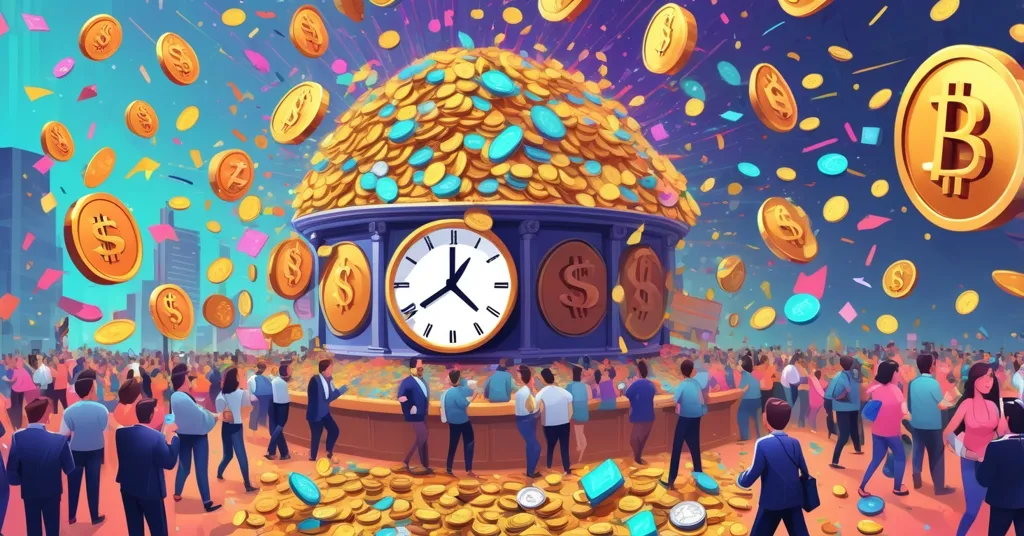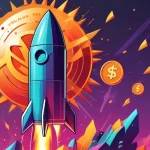Pump.fun Raises $600M in 12 Minutes: Meme Coin Frenzy Hits Solana

Meme Coin Mania: Pump.fun Raises $600 Million in Just 12 Minutes
Pump.fun, a Solana-based platform for minting meme coins, has pulled off an unprecedented feat, raising a staggering $600 million in just 12 minutes during a recent initial coin offering (ICO). This jaw-dropping sum, marking one of the largest ICOs ever, comes hot on the heels of Bitcoin’s new all-time high and signals a wild resurgence of meme coin fever sweeping the crypto space.
- Historic Raise: $600 million in 12 minutes, with total funds at $1.32 billion after private sales.
- Meme Coin Frenzy: Pump.fun fuels a speculative surge on Solana, blending viral culture with finance.
- Regulatory Barriers: US and UK investors excluded due to strict oversight laws.
This isn’t just a flashy headline—it’s a window into the chaotic brilliance of crypto, where internet memes morph into speculative assets overnight, and market sentiment swings from terror to unbridled FOMO faster than you can refresh a trading app. Let’s break down Pump.fun’s meteoric rise, explore what’s driving this meme coin madness, and cut through the hype with a hard look at the risks and realities. Buckle up; this is crypto at its most unhinged.
Pump.fun’s Rise: Behind the Numbers
On a single Saturday, Pump.fun sold 150 billion tokens at $0.004 each in a public sale, following an earlier private round where 180 billion tokens were snapped up at the same price. Total funds raised? A cool $1.32 billion, as confirmed by co-founder Alon Cohen in a statement to Bloomberg News. Trading of these tokens is set to begin 48 to 72 hours after the sale, leaving investors with a narrow window to brace for the inevitable volatility. Since its debut in 2024, the platform has generated nearly $800 million in revenue, cementing its dominance in the meme coin niche on the Solana blockchain. For deeper insights into this staggering achievement, check out the detailed analysis of Pump.fun’s $600 million raise.
For those new to the game, Solana is a layer-1 blockchain built for speed and efficiency, acting like a high-speed highway for digital transactions compared to Ethereum’s often congested roads. Its low fees and fast processing make it a magnet for speculative projects like meme coins—digital tokens often inspired by internet jokes or viral trends, such as Dogecoin or Shiba Inu, but usually with zero pretense of real-world utility. Pump.fun capitalizes on this by letting users mint their own meme coins in minutes for a small fee, while the platform takes a cut of the trading volume. It’s a gamified casino of token creation, and tens of thousands of users have jumped in, chasing the next viral hit. If you’re curious about how it compares to others, here’s a look at various Solana meme coin platforms.
The timing of this raise adds fuel to the fire. Just one day before Pump.fun’s ICO, Bitcoin hit a new all-time high, a bullish signal that often lifts altcoins and speculative assets in its wake. As Zaheer Ebtikar, founder of crypto fund Split Capital, put it:
“People go from max fear to max FOMO very quickly.”
This encapsulates the bipolar nature of crypto markets, where rational analysis is frequently drowned out by the roar of hype. But as Bitcoin maximalists, we can’t help but raise an eyebrow. While Bitcoin stands as the ultimate decentralized store of value, meme coins on Solana represent a different beast—chaotic experiments that, for better or worse, draw new eyes to the broader world of crypto.
Meme Coin Mania: Culture Meets Capital
Meme coins are the bizarre lovechild of internet culture and speculative finance, and Pump.fun is their favorite playground. What drives this craze? It’s a mix of viral trends, community dynamics, and the tantalizing promise of quick gains. A single tweet, meme, or TikTok can send a token’s value soaring—or crashing. High-profile endorsements only amplify the madness. Take the rumor of former US President Donald Trump launching his own meme coin ahead of a supposed second inauguration in January 2025. While details remain unconfirmed and community chatter on platforms like Reddit is thick with wild speculation—some even pegging its potential market cap to rival Dogecoin’s $50 billion—this kind of celebrity involvement shows how meme coins have clawed their way into mainstream consciousness. For more on these discussions, see the buzz around Trump coin predictions. It’s absurd, sure, but it’s also a magnet for retail investors and thrill-seekers alike.
Let’s play devil’s advocate for a moment. Are meme coins just gambling with extra steps, or do they represent a legitimate cultural phenomenon? On one hand, tokens like Dogecoin have shown surprising longevity, even gaining acceptance as payment in some corners, with market caps in the billions. They can act as on-ramps for younger generations, like Gen Z, who stumble into crypto via social media trends and end up learning about blockchain. On the other hand, stats paint a grim picture—over 90% of meme coins fail within months, often leaving latecomers holding worthless bags. It’s a high-stakes game where the house, or rather the early insiders, usually wins. Still, the sheer energy of meme coin mania is undeniable, and platforms like Pump.fun are onboarding users to decentralization in ways Bitcoin alone can’t match. If you’re wondering what fuels meme coin hype on Solana, there’s plenty of debate out there.
Regulatory Roadblocks and Historical Echoes
Not everyone could join Pump.fun’s gold rush. Investors from the US and UK were barred from the sale due to regulatory restrictions, a blunt reminder that the crypto Wild West is increasingly corralled by government oversight. These jurisdictions, burned by past retail investor losses, remain wary of high-risk offerings like ICOs. And they’ve got reason to be cautious. Back in 2018, ICO fundraising peaked at $3 billion monthly before collapsing under a wave of scams, rug pulls—where developers vanish with investor funds after a token launch—and outright fraud. Infamous cases like Bitconnect, a Ponzi scheme masquerading as a lending platform, left countless investors ruined and regulators scrambling to tighten the screws. For a broader perspective on crypto’s turbulent history, take a look at this in-depth crypto history piece.
Pump.fun’s massive raise, while transparent so far, echoes that era of unchecked hype. Excluding major markets didn’t slow the momentum, but it raises a red flag: can this fundraising model endure as global regulators sharpen their focus? Without clearer frameworks, we might be watching history repeat itself, with meme coin mania paving the way for another bust. It’s a tension at the heart of crypto—freedom to innovate versus the need to protect the unwary. We champion decentralization and disrupting the status quo, but let’s not pretend scams aren’t thriving on this hype. Before diving into any meme coin, do your homework on the team, tokenomics, and community—scammers love a feeding frenzy.
Social Trading Ambitions: The Kolscan Acquisition
Pump.fun isn’t content to just be a meme coin factory. Its recent acquisition of Kolscan, a Solana-based wallet tracking tool, hints at bigger plans to morph into a full-fledged crypto social media platform. Kolscan lets users peek into wallet activities and track trading patterns, bringing a layer of transparency to the often murky meme coin space. Alon Cohen described trading as a “social sport,” emphasizing community and shared insights as key to the ecosystem’s appeal. As he told Bloomberg:
“We’re aiming for completely new experiences in on-chain trading.”
By keeping Kolscan free for users, Pump.fun is doubling down on this vision. Imagine stalking a whale’s wallet moves while swapping strategies with friends in real-time—think of it as Twitch for crypto speculation, part game, part gossip, all high stakes. This taps into the growing trend of social finance, where trading platforms become community hubs. It’s a smart play, aligning with our push for effective accelerationism—using tech to disrupt and empower at breakneck speed. For more on this strategic move, check out the latest on Pump.fun’s acquisition of Kolscan. But will it be enough to keep Pump.fun ahead of the pack?
Risks and Realities: Competition and Cracks
Let’s cut the bullshit: Pump.fun’s success isn’t a guaranteed fairy tale. Its market share in the Solana meme coin arena has slipped below 60%, with competitors like LetsBonk—a platform with similar token creation tools but often lower fees—gaining ground. Revenue losses are piling up, and the meme coin space is getting crowded fast. Oversaturation is a real threat; when everyone’s minting the next viral token, how many can actually stick? Add to that the strain meme coin trading puts on Solana’s network—massive transaction volumes can lead to congestion, raising questions about scalability compared to rivals like Ethereum or even Bitcoin’s lightning network for microtransactions. Community reactions to this rapid growth are heating up, as seen in discussions around Pump.fun’s Solana ICO success.
Then there’s the darker side of meme coins and ICOs. Rug pulls remain rampant, with developers hyping tokens only to disappear with the cash. Historical busts like 2018’s ICO crash loom large, and while Pump.fun’s transparency efforts are a step up, they’re no ironclad shield. From a Bitcoin maximalist lens, these speculative bubbles can tarnish crypto’s reputation as serious money—every scam headline makes Bitcoin’s mission as a decentralized store of value harder to pitch. Yet, there’s a flip side: if even a fraction of meme coin speculators convert their gains (or losses) into Bitcoin, or fund BTC development indirectly, these wild experiments might have a silver lining. It’s messy, but crypto thrives on mess.
Key Takeaways and Questions
- What does Pump.fun’s $600 million raise signify for crypto markets?
It marks a roaring comeback for ICOs and meme coin speculation, turbocharged by Bitcoin’s bullish run, but also flags potential overexuberance and regulatory pushback. - Why were US and UK investors locked out of the sale?
Strict regulations in these regions aim to shield retail investors from high-risk crypto ventures, reflecting ongoing global caution toward unchecked ICOs. - How does Kolscan’s acquisition position Pump.fun for the future?
By boosting analytics and social trading features, it aims to turn Pump.fun into a community-driven hub, reimagining on-chain trading as a shared, interactive experience. - What fuels meme coin hype, and can it last?
Internet culture, viral moments, and celebrity buzz—like unverified Trump coin rumors—drive interest, but with 90% of meme coins failing and historical ICO crashes as precedent, sustainability without safeguards looks shaky. - Do meme coins matter to Bitcoin maximalists?
While Bitcoin reigns as the true decentralized money, meme coins on Solana fill experimental niches Bitcoin doesn’t touch, acting as chaotic gateways to broader crypto adoption despite their flaws.
Pump.fun’s lightning-fast raise is a screaming testament to crypto’s raw, disruptive power—a space where innovation and insanity often blur. It embodies why we fight for decentralization: the freedom to experiment, to challenge norms, to accelerate progress. But it’s also a glaring warning. For every dreamer minting a meme coin, there’s a predator waiting to exploit the hype. We’re all for pushing tech and ideas to their limits, but not at the expense of reason. So keep your skepticism sharp and your wallet secure. After all, in this game, FOMO might be the bait, but critical thinking is the hook that keeps you safe. Are meme coins a stepping stone to decentralization or a flashy distraction from Bitcoin’s core mission? That’s for you to chew on.



